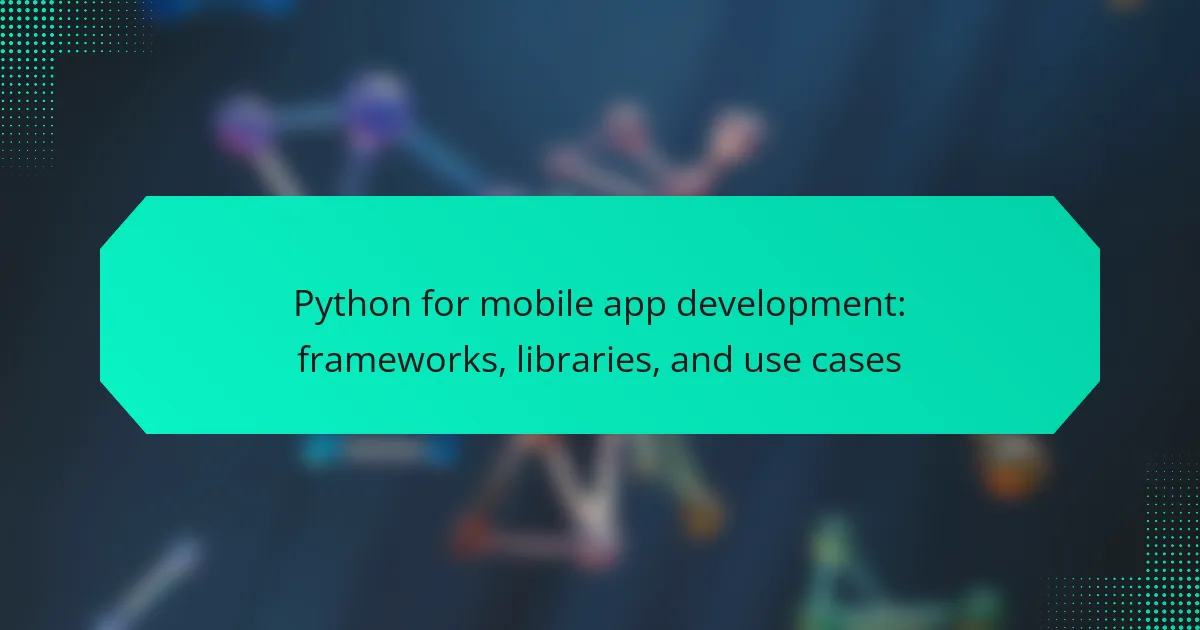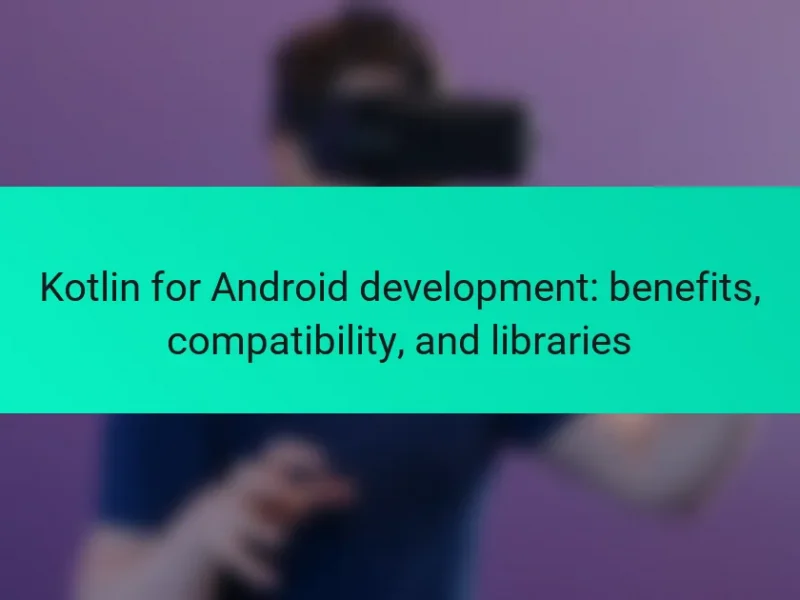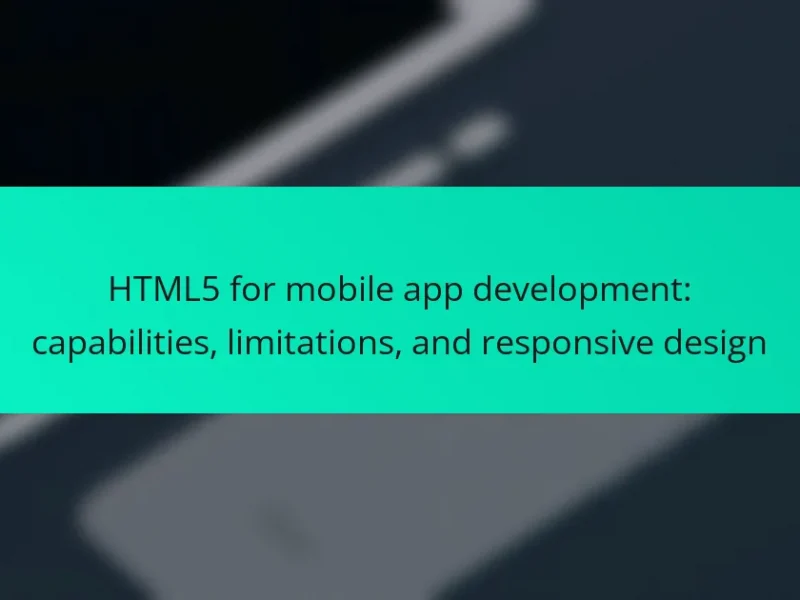Python is a programming language widely utilized for mobile app development, particularly for creating cross-platform applications. Key frameworks such as Kivy, BeeWare, and PyQt enhance the development process by offering tools for building multitouch and native applications across various platforms, including iOS and Android. Kivy simplifies the creation of multi-touch applications, while BeeWare provides the capability to write native apps in Python. PyQt allows developers to create applications with a native look and feel using the Qt framework. Python’s readability, extensive libraries, and growing community support make it a versatile choice for integrating functionalities like data analysis and machine learning into mobile applications.

What is Python for mobile app development?
Python is a programming language used for mobile app development. It offers frameworks like Kivy and BeeWare for building cross-platform applications. Kivy allows developers to create multi-touch applications easily. BeeWare provides tools to write native applications for various platforms. Python’s simplicity and readability enhance the development process. Its extensive libraries support various functionalities, from data analysis to user interface design. The language’s growing popularity in mobile development is evidenced by a vibrant community and ongoing updates.
How does Python facilitate mobile app development?
Python facilitates mobile app development through various frameworks and libraries. These tools streamline the app development process. Kivy is a popular framework that allows for multi-platform applications. It supports touch interfaces and is suitable for both Android and iOS. Another framework, BeeWare, enables developers to write native apps in Python. It compiles Python code into native code for various platforms. PyQt and PySide are libraries for creating cross-platform applications with rich user interfaces. They provide a robust set of tools for GUI development. Python’s simplicity and readability enhance productivity in app development. These attributes make it easier for developers to maintain and update code.
What are the key features of Python that support mobile app development?
Python supports mobile app development through its simplicity, readability, and extensive libraries. Its syntax is clear and concise, making it accessible for developers. Python has frameworks like Kivy and BeeWare, specifically designed for mobile applications. These frameworks enable cross-platform development, allowing apps to run on both iOS and Android. Python’s vast library ecosystem provides tools for various functionalities, such as data handling and user interface design. Additionally, Python’s community support is robust, offering resources and documentation for developers. These key features facilitate efficient and effective mobile app development using Python.
How does Python compare to other programming languages for mobile app development?
Python is less commonly used for mobile app development compared to languages like Java, Swift, or Kotlin. While Python offers frameworks such as Kivy and BeeWare, they lack the extensive support and performance optimizations found in native languages. Java is the primary language for Android development, providing direct access to Android APIs. Swift and Kotlin offer modern features and seamless integration with iOS and Android ecosystems, respectively. According to a 2021 Stack Overflow survey, Java and Swift are among the top choices for mobile developers. Python’s performance can be slower, making it less suitable for resource-intensive applications.
What are the advantages of using Python for mobile app development?
Python offers several advantages for mobile app development. Its simplicity and readability make it easy for developers to learn and use. Python has a rich ecosystem of libraries and frameworks, such as Kivy and BeeWare, which facilitate mobile app creation. These frameworks allow for rapid development and prototyping, saving time and resources. Python also supports cross-platform development, enabling apps to run on both iOS and Android with minimal changes. Additionally, Python’s strong community support provides extensive resources and documentation, aiding developers in troubleshooting and enhancing their projects. Overall, these attributes contribute to Python’s growing popularity in mobile app development.
How does Python enhance productivity in mobile app development?
Python enhances productivity in mobile app development through its simplicity and extensive libraries. Its syntax is clear and concise, which reduces the learning curve for developers. This allows for faster coding and easier debugging. Python offers frameworks like Kivy and BeeWare, which streamline the development process. These frameworks provide pre-built components and tools that save time. Additionally, Python’s large community contributes to a wealth of resources and documentation. This support accelerates problem-solving and implementation. The combination of these factors leads to quicker project completion and improved efficiency in mobile app development.
What are the cost benefits of using Python for mobile applications?
Python reduces development costs for mobile applications due to its simplicity and efficiency. The language has a straightforward syntax, allowing developers to write code faster. This leads to shorter development cycles and reduced labor costs. Python’s extensive libraries and frameworks, such as Kivy and BeeWare, provide pre-built functionalities. This minimizes the need for custom code, further lowering expenses. Additionally, Python’s cross-platform capabilities enable developers to create apps for multiple operating systems simultaneously. This eliminates the need for separate teams for iOS and Android development. According to a survey by Stack Overflow, Python is one of the most popular languages, which translates to a larger pool of available developers. This competitive market can drive down hiring costs. Overall, Python’s cost benefits stem from its efficiency, extensive resources, and broad developer community.
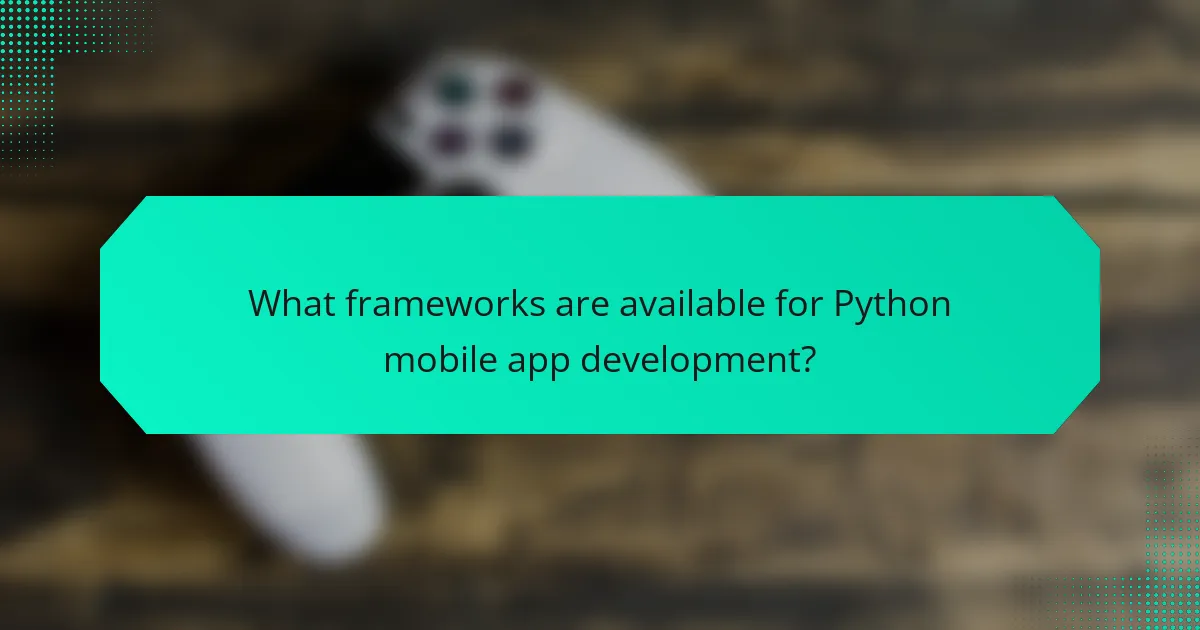
What frameworks are available for Python mobile app development?
Kivy, BeeWare, and PyQt are prominent frameworks available for Python mobile app development. Kivy is an open-source Python library for developing multitouch applications. It supports various platforms, including iOS and Android. BeeWare allows developers to write native applications in Python, offering tools for UI design and packaging. PyQt is a set of Python bindings for the Qt application framework. It enables the creation of cross-platform applications with a native look and feel. These frameworks provide diverse options for developers looking to create mobile applications using Python.
What are the most popular Python frameworks for mobile app development?
The most popular Python frameworks for mobile app development are Kivy, BeeWare, and PyQt. Kivy is known for its ability to create cross-platform applications. It supports multi-touch and is suitable for both Android and iOS. BeeWare allows developers to write native applications using Python. It provides tools for packaging and deploying apps on multiple platforms. PyQt is a set of Python bindings for the Qt application framework. It is used for creating desktop and mobile applications with a rich user interface. These frameworks are widely recognized in the developer community for their functionality and ease of use.
How does Kivy support mobile app development?
Kivy supports mobile app development by providing a framework that is cross-platform and open-source. It allows developers to write applications in Python and deploy them on multiple operating systems, including iOS and Android. Kivy includes a rich set of UI controls and tools for creating multi-touch applications. Its graphics engine is built on OpenGL ES 2, which enhances performance for mobile devices. Kivy also supports various input methods, such as touch, mouse, and keyboard. The framework is designed to facilitate rapid development with its easy-to-use API. Kivy’s community offers extensive documentation and resources for developers. This combination of features makes Kivy a popular choice for mobile app development using Python.
What are the unique features of BeeWare for mobile apps?
BeeWare offers several unique features for mobile apps. It enables developers to write applications in Python, which is a highly readable and versatile programming language. BeeWare provides a suite of tools for building native applications across multiple platforms, including iOS and Android. It utilizes a single codebase, which simplifies the development process. BeeWare’s Toga library allows for the creation of native user interfaces that adhere to platform-specific design guidelines. Additionally, it supports access to native device features through the Rubicon library. This allows developers to integrate functionalities like GPS, camera, and notifications seamlessly. Overall, BeeWare empowers Python developers to create cross-platform mobile applications with native performance and appearance.
How do these frameworks differ in their approach?
Different Python frameworks for mobile app development differ in their approach to application architecture and user interface design. For instance, Kivy focuses on providing a multi-touch user interface and supports various platforms. In contrast, BeeWare emphasizes native user interface components, allowing developers to create apps that feel more integrated with the operating system.
Additionally, Flask is a micro-framework that offers simplicity and flexibility for backend development, while Django is a high-level framework that promotes rapid development with a built-in ORM. These differences impact how developers structure their code and manage app functionality. Each framework’s unique approach influences the development process and the final user experience.
What are the pros and cons of using Flask for mobile applications?
Flask offers several pros and cons for mobile application development.
Pros include its lightweight nature, which allows for quick development and easy scalability. Flask’s flexibility enables developers to choose various components and libraries as needed. Its simplicity and minimalistic design make it beginner-friendly. Additionally, Flask has a strong community and extensive documentation, providing ample resources for developers.
Cons include limited built-in features compared to more comprehensive frameworks. Flask may require additional libraries for functionalities like authentication and database integration. Performance can be an issue for larger applications due to its micro-framework nature. Furthermore, managing complex applications can become challenging without a clear structure.
These factors should be considered when deciding to use Flask for mobile applications.
How does Django compare to other frameworks in mobile app development?
Django is primarily a web framework and is not specifically designed for mobile app development. Unlike frameworks such as React Native or Flutter, which are optimized for building mobile applications, Django focuses on server-side development. Django excels in rapid development and scalability for web applications. It provides robust features like ORM, authentication, and an admin interface, which can support backend services for mobile apps. However, it lacks native mobile UI components that frameworks built for mobile offer. Therefore, while Django can be used in conjunction with mobile frameworks for backend services, it is not a direct competitor in mobile app development.

What libraries enhance Python mobile app development?
Kivy, BeeWare, and PyQt are libraries that enhance Python mobile app development. Kivy is an open-source Python library for developing multitouch applications. It supports various platforms, including Android and iOS. BeeWare allows developers to write native applications in Python. It provides tools to create applications for multiple operating systems. PyQt is a set of Python bindings for the Qt application framework. It enables the development of cross-platform applications with a native look and feel. These libraries facilitate the creation of mobile applications using Python efficiently.
What libraries are essential for Python mobile development?
Kivy, BeeWare, and PyQt are essential libraries for Python mobile development. Kivy is a popular library for building multitouch applications. It supports various platforms including Android and iOS. BeeWare allows developers to write native applications in Python. It provides tools to package Python code for different operating systems. PyQt is a set of Python bindings for the Qt libraries. It is useful for creating cross-platform applications with a native look and feel. Each library offers unique features that cater to mobile development needs.
How does NumPy contribute to mobile app functionalities?
NumPy enhances mobile app functionalities by providing efficient numerical computations. Its array operations allow for fast data manipulation, crucial for performance-sensitive applications. NumPy supports multi-dimensional arrays, enabling complex data structures necessary for scientific and statistical applications. It also offers a wide range of mathematical functions, facilitating advanced calculations directly within mobile apps. Many mobile applications in data science and machine learning rely on NumPy for backend processing. For instance, apps that require real-time data analysis can leverage NumPy’s capabilities to process large datasets efficiently. The library’s compatibility with other Python libraries further extends its utility in mobile development. Overall, NumPy’s speed and versatility make it a valuable tool in enhancing mobile app functionalities.
What role does Requests play in mobile app development?
Requests is a Python library that simplifies making HTTP requests in mobile app development. It allows developers to easily send GET, POST, and other types of requests to web services. This functionality is essential for mobile applications that need to communicate with remote APIs. Requests handles various complexities of HTTP, such as authentication and session management. By using Requests, developers can focus on building app features rather than managing network connections. The library is widely adopted due to its simplicity and ease of use. Its comprehensive documentation supports developers in implementing it effectively.
How can libraries improve the efficiency of mobile app development?
Libraries can improve the efficiency of mobile app development by providing pre-built functions and tools. They reduce the amount of code developers need to write. This leads to faster development cycles. Libraries also ensure consistency in coding practices. They often include optimized algorithms and data structures. This enhances performance and reduces bugs. For example, libraries like Kivy and Flask streamline the development process. They offer features such as UI design and backend integration. Using libraries can significantly cut down on development time and resources.
What are the best practices for integrating libraries into Python mobile apps?
Use virtual environments to manage dependencies for Python mobile apps. This practice isolates project-specific packages and avoids conflicts. Next, utilize package managers like pip to install libraries efficiently. Always check library compatibility with the chosen mobile framework. Prioritize libraries with active community support and regular updates. This ensures better maintenance and troubleshooting. Additionally, keep the app’s size in mind; avoid bloating it with unnecessary libraries. Optimize imports to include only required modules. Finally, document all library integrations for future reference and maintenance.
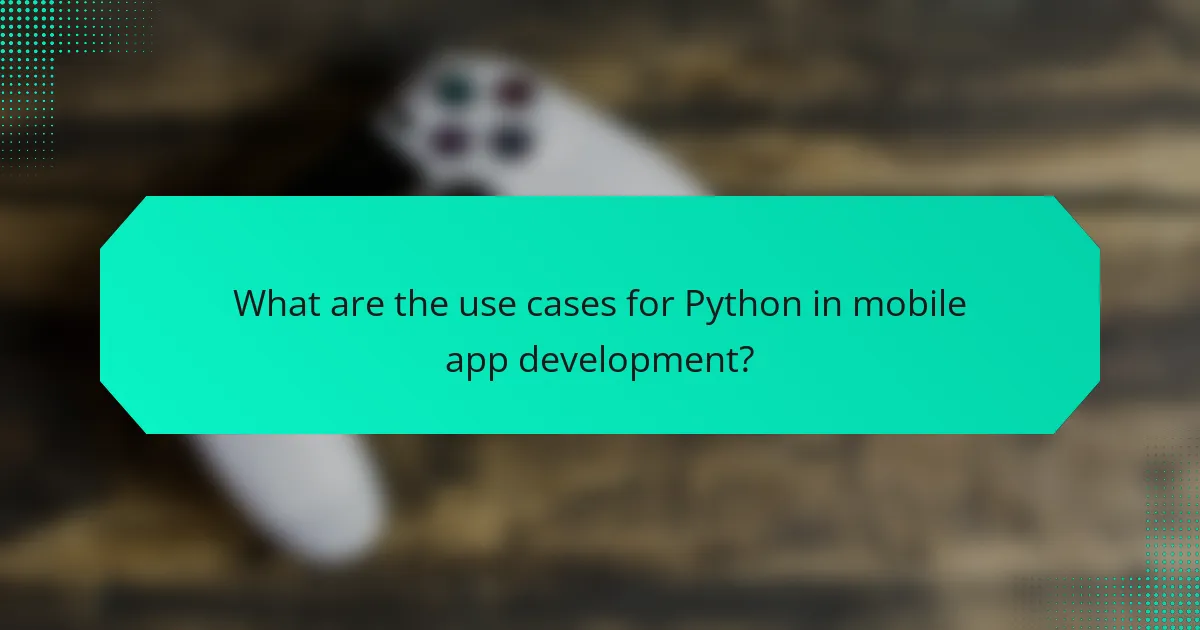
What are the use cases for Python in mobile app development?
Python is used in mobile app development primarily for creating cross-platform applications. Frameworks like Kivy and BeeWare enable developers to write code once and deploy it on multiple platforms. Python’s simplicity accelerates the development process, allowing for rapid prototyping. It also integrates well with other languages, enhancing functionality through APIs. Additionally, Python is used for backend development, managing databases and server-side logic. Data analysis and machine learning features can be incorporated into mobile apps using Python libraries. These capabilities make Python a versatile choice for mobile app development.
What types of mobile applications can be developed using Python?
Python can be used to develop various types of mobile applications. These include cross-platform applications that run on both Android and iOS. Python frameworks like Kivy and BeeWare facilitate the creation of these applications. Additionally, Python can be utilized for backend development in mobile apps, providing server-side logic. Some apps focus on data visualization, leveraging libraries like Matplotlib. Games can also be developed using Python, particularly with libraries such as Pygame. Furthermore, Python is effective for prototyping mobile applications due to its rapid development capabilities.
How is Python used in developing educational apps?
Python is used in developing educational apps primarily due to its simplicity and readability. Developers leverage Python’s extensive libraries, such as Django and Flask, to create robust backend systems for these applications. Python also supports various frameworks that facilitate rapid development, making it ideal for educational tools that require quick iterations. Additionally, libraries like Kivy allow for cross-platform app development, enabling educational apps to run on multiple devices. Its integration with data analysis libraries, such as Pandas and NumPy, enhances the app’s ability to manage and analyze educational data effectively. Python’s community support provides a wealth of resources and documentation, aiding developers in overcoming challenges during the app development process.
What are some examples of Python in gaming applications?
Python is used in various gaming applications, showcasing its versatility. Pygame is a popular library for game development in Python. It enables the creation of 2D games with ease. Another example is Panda3D, which supports 3D game development. It offers a comprehensive engine and tools for developers. Additionally, Blender uses Python for scripting and game logic. This allows for custom game functionalities within the software. Python is also utilized in game development for AI programming. Many developers use it for creating non-player character behaviors. These examples illustrate Python’s effectiveness in the gaming industry.
What industries benefit from Python mobile app development?
Technology, finance, healthcare, education, and entertainment industries benefit from Python mobile app development. Python’s versatility allows for rapid development and prototyping. In technology, companies leverage Python for building scalable applications. The finance sector utilizes Python for data analysis and algorithmic trading apps. Healthcare organizations use Python for developing patient management and telemedicine applications. Educational institutions create learning platforms and tools using Python. The entertainment industry employs Python for game development and media streaming applications. These industries value Python’s extensive libraries and frameworks, which enhance functionality and speed up the development process.
How is Python utilized in healthcare mobile applications?
Python is utilized in healthcare mobile applications for data analysis, machine learning, and backend development. Its libraries like Pandas and NumPy facilitate efficient data manipulation and analysis. Python’s machine learning frameworks, such as TensorFlow and Scikit-learn, enable predictive analytics for patient outcomes. Django and Flask are popular for building robust backend systems that support mobile apps. Python’s simplicity accelerates development, allowing for quicker iterations and deployment. According to a 2022 report by ResearchAndMarkets, Python’s use in healthcare technology is expected to grow significantly due to its versatility and effectiveness.
What are the applications of Python in finance-related mobile apps?
Python is widely used in finance-related mobile apps for various applications. It facilitates data analysis, allowing developers to create apps that analyze market trends and financial data efficiently. Python’s libraries, such as Pandas and NumPy, support complex calculations and data manipulation. It is also utilized for algorithmic trading applications, enabling automated trading strategies based on real-time data. Python’s integration with machine learning frameworks, like TensorFlow and Scikit-learn, allows for predictive analytics in finance. Additionally, Python supports the development of user-friendly interfaces through frameworks like Kivy and BeeWare. The language’s versatility and extensive libraries make it a preferred choice for building finance-related mobile applications.
What are the best practices for developing mobile apps with Python?
The best practices for developing mobile apps with Python include using appropriate frameworks, following coding standards, and testing thoroughly. Frameworks like Kivy and BeeWare facilitate mobile app development. They provide tools for building cross-platform applications efficiently. Adhering to coding standards improves code readability and maintainability. This practice is essential for team collaboration. Implementing version control systems like Git enhances project management. Effective testing ensures the app functions correctly across devices. Automated testing tools can streamline this process. Additionally, optimizing performance is crucial for user satisfaction. Utilizing Python libraries can aid in achieving this optimization.
How can developers ensure optimal performance in Python mobile apps?
Developers can ensure optimal performance in Python mobile apps by utilizing efficient libraries and frameworks. Choosing frameworks like Kivy or BeeWare allows for better resource management. Developers should also minimize the use of global variables to reduce memory overhead. Implementing asynchronous programming can enhance responsiveness. Profiling tools, such as cProfile, help identify performance bottlenecks. Code optimization techniques, like using built-in functions, can improve execution speed. Additionally, leveraging native components through bridging can enhance performance significantly. These strategies collectively lead to improved app performance and user experience.
What common pitfalls should be avoided in Python mobile app development?
Common pitfalls in Python mobile app development include neglecting performance optimization. Python can be slower than other languages, affecting user experience. Developers often overlook platform-specific guidelines. This can lead to poor app integration and usability. Failing to test on multiple devices is another issue. It results in unoptimized performance across different screen sizes and resolutions. Additionally, not utilizing appropriate frameworks can hinder development efficiency. Frameworks like Kivy or BeeWare provide essential tools but are sometimes ignored. Lastly, inadequate error handling can lead to app crashes. This undermines user trust and satisfaction.
Python is a versatile programming language increasingly used for mobile app development, supported by frameworks such as Kivy and BeeWare. These frameworks facilitate cross-platform application creation, allowing developers to build apps for both iOS and Android efficiently. The article explores the key features of Python that enhance productivity, including its simplicity, readability, and extensive libraries, as well as its advantages and cost benefits in mobile development. Additionally, it examines various use cases for Python in different industries, highlighting its applications in healthcare, finance, and education, along with best practices and common pitfalls to avoid during development.
